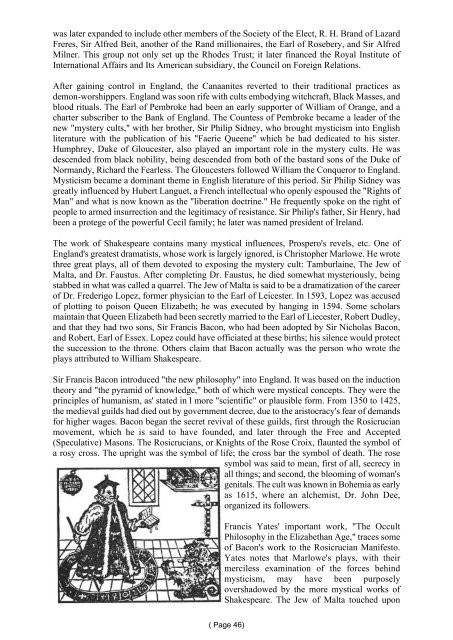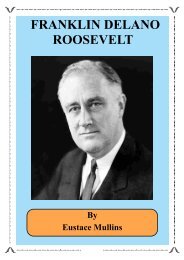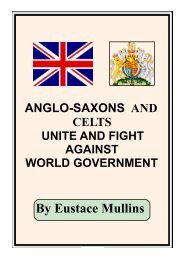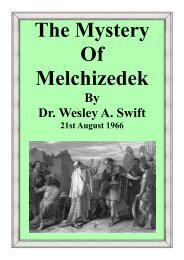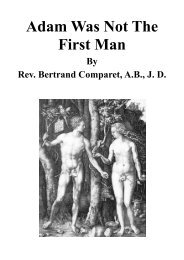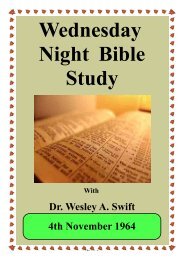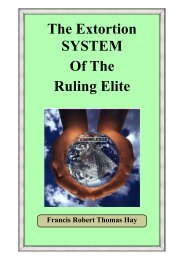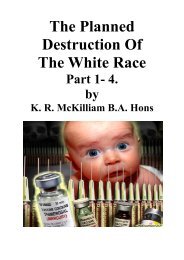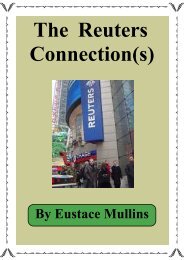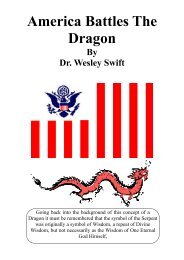Curse of Cannan - The New Ensign
Curse of Cannan - The New Ensign
Curse of Cannan - The New Ensign
Create successful ePaper yourself
Turn your PDF publications into a flip-book with our unique Google optimized e-Paper software.
was later expanded to include other members <strong>of</strong> the Society <strong>of</strong> the Elect, R. H. Brand <strong>of</strong> Lazard<br />
Freres, Sir Alfred Beit, another <strong>of</strong> the Rand millionaires, the Earl <strong>of</strong> Rosebery, and Sir Alfred<br />
Milner. This group not only set up the Rhodes Trust; it later financed the Royal Institute <strong>of</strong><br />
International Affairs and Its American subsidiary, the Council on Foreign Relations.<br />
After gaining control in England, the Canaanites reverted to their traditional practices as<br />
demon-worshippers. England was soon rife with cults embodying witchcraft, Black Masses, and<br />
blood rituals. <strong>The</strong> Earl <strong>of</strong> Pembroke had been an early supporter <strong>of</strong> William <strong>of</strong> Orange, and a<br />
charter subscriber to the Bank <strong>of</strong> England. <strong>The</strong> Countess <strong>of</strong> Pembroke became a leader <strong>of</strong> the<br />
new "mystery cults," with her brother, Sir Philip Sidney, who brought mysticism into English<br />
literature with the publication <strong>of</strong> his "Faerie Queene" which he had dedicated to his sister.<br />
Humphrey, Duke <strong>of</strong> Gloucester, also played an important role in the mystery cults. He was<br />
descended from black nobility, being descended from both <strong>of</strong> the bastard sons <strong>of</strong> the Duke <strong>of</strong><br />
Normandy, Richard the Fearless. <strong>The</strong> Gloucesters followed William the Conqueror to England.<br />
Mysticism became a dominant theme in English literature <strong>of</strong> this period. Sir Philip Sidney was<br />
greatly influenced by Hubert Languet, a French intellectual who openly espoused the "Rights <strong>of</strong><br />
Man" and what is now known as the "liberation doctrine." He frequently spoke on the right <strong>of</strong><br />
people to armed insurrection and the legitimacy <strong>of</strong> resistance. Sir Philip's father, Sir Henry, had<br />
been a protege <strong>of</strong> the powerful Cecil family; he later was named president <strong>of</strong> Ireland.<br />
<strong>The</strong> work <strong>of</strong> Shakespeare contains many mystical influences, Prospero's revels, etc. One <strong>of</strong><br />
England's greatest dramatists, whose work is largely ignored, is Christopher Marlowe. He wrote<br />
three great plays, all <strong>of</strong> them devoted to exposing the mystery cult: Tamburlaine, <strong>The</strong> Jew <strong>of</strong><br />
Malta, and Dr. Faustus. After completing Dr. Faustus, he died somewhat mysteriously, being<br />
stabbed in what was called a quarrel. <strong>The</strong> Jew <strong>of</strong> Malta is said to be a dramatization <strong>of</strong> the career<br />
<strong>of</strong> Dr. Frederigo Lopez, former physician to the Earl <strong>of</strong> Leicester. In 1593, Lopez was accused<br />
<strong>of</strong> plotting to poison Queen Elizabeth; he was executed by hanging in 1594. Some scholars<br />
maintain that Queen Elizabeth had been secretly married to the Earl <strong>of</strong> Liecester, Robert Dudley,<br />
and that they had two sons, Sir Francis Bacon, who had been adopted by Sir Nicholas Bacon,<br />
and Robert, Earl <strong>of</strong> Essex. Lopez could have <strong>of</strong>ficiated at these births; his silence would protect<br />
the succession to the throne. Others claim that Bacon actually was the person who wrote the<br />
plays attributed to William Shakespeare.<br />
Sir Francis Bacon introduced "the new philosophy" into England. It was based on the induction<br />
theory and "the pyramid <strong>of</strong> knowledge," both <strong>of</strong> which were mystical concepts. <strong>The</strong>y were the<br />
principles <strong>of</strong> humanism, as' stated in l more "scientific" or plausible form. From 1350 to 1425,<br />
the medieval guilds had died out by government decree, due to the aristocracy's fear <strong>of</strong> demands<br />
for higher wages. Bacon began the secret revival <strong>of</strong> these guilds, first through the Rosicrucian<br />
movement, which he is said to have founded, and later through the Free and Accepted<br />
(Speculative) Masons. <strong>The</strong> Rosicrucians, or Knights <strong>of</strong> the Rose Croix, flaunted the symbol <strong>of</strong><br />
a rosy cross. <strong>The</strong> upright was the symbol <strong>of</strong> life; the cross bar the symbol <strong>of</strong> death. <strong>The</strong> rose<br />
symbol was said to mean, first <strong>of</strong> all, secrecy in<br />
all things; and second, the blooming <strong>of</strong> woman's<br />
genitals. <strong>The</strong> cult was known in Bohemia as early<br />
as 1615, where an alchemist, Dr. John Dee,<br />
organized its followers.<br />
Francis Yates' important work, "<strong>The</strong> Occult<br />
Philosophy in the Elizabethan Age," traces some<br />
<strong>of</strong> Bacon's work to the Rosicrucian Manifesto.<br />
Yates notes that Marlowe's plays, with their<br />
merciless examination <strong>of</strong> the forces behind<br />
mysticism, may have been purposely<br />
overshadowed by the more mystical works <strong>of</strong><br />
Shakespeare. <strong>The</strong> Jew <strong>of</strong> Malta touched upon<br />
( Page 46)


